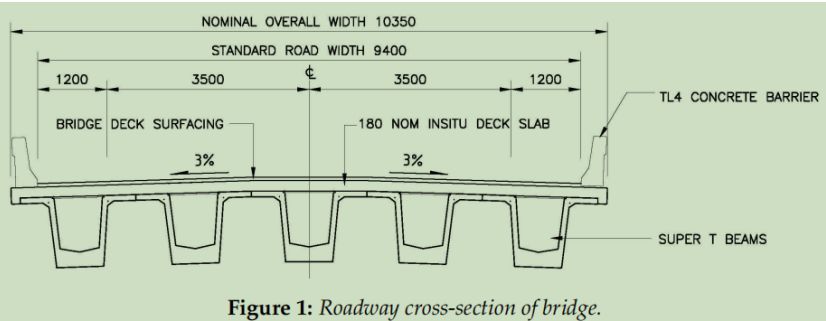"Super-T Bridge Design"- Project
- Subject Code :
CIV6170
- University :
Monash University Exam Question Bank is not sponsored or endorsed by this college or university.
- Country :
Australia
1 Overview
A client has just been in touch to confirm that your recent tender has been successful and awarded your firm the contract for the design for a skewed single-span Super-T bridge. You have been appointed as the Bridge Engineer on this project. You are to produce a detailed design that meets the client requests, and present the solution in a Final Deliverable (prelude document, hand calculations, and hand-drawn sketches).
The bridge is required to carry one traffic lane in each direction, with a 1.2 m shoulder (emergency lane) either side. The road layout and bridge cross-section are shown in Figure 1.  The bridge is to cross a waterway with steep banks on either side, as shown in Figure 2. The bridge is skewed, and to provide 10 m clearance above high water level, maximum water depth is 5 m at the centre of the v-shaped creek. The water way is regularly trafficked by leisure craft.
The bridge is to cross a waterway with steep banks on either side, as shown in Figure 2. The bridge is skewed, and to provide 10 m clearance above high water level, maximum water depth is 5 m at the centre of the v-shaped creek. The water way is regularly trafficked by leisure craft.

2 Client Requests
2.1 Bridge Skew and Length
Each bridge engineer will have a specific bridge length and skew assigned. You will then be informed your bridge skew and length on Moodle. In general, lengths will range from 15 to 40 m and skews from 5? to 30?.
2.2 Technical Requirements
Your client has made a number of technical requests:
- The bridge is to be designed according to AS5100-2017 (+ Amdt 1 2018).
- Assume that S1600 loading is not the critical case for your bridge.
- Super-T girders must be used as the method of construction and be pretensioned with 15.2 mm diameter super strands with straight horizontal profile to 75% of strand capacity.
- No other diameter is permissible;
- Initial prestress may vary, but not without strong justification and reference to precedence.
- The 28-day concrete strength for the girder can be initially taken as 65 MPa, and the transfer strength as 40 MPa.
- Background reading and manufacturers technical data could be examined to determine alternative values to this. Where a variation is sought, strong justification must be made with reference to precedence.
- A 180 mm cast-in-situ one-way concrete overlay slab is adopted and once set will act compositely with the girder.
- The 28-day concrete strength for the slab is preferred to be 40 MPa and must not exceed 50 MPa in any case.
- TL4 concrete barriers (2 tonnes per 3 m) and 55 mm asphalt surfacing is to be provided (22 kN/m3 ) as superimposed dead load.
3 Weekly Deliverables
During the semester you will work individually with the assistance of other students and the teaching team (during practical classes) on the weekly deliverables (hand calculations). These are the individual task form the project and provide feedback on your progress. You are required to submit a draft of your work. It is not required that this be the final version that appears in the Final Deliverable (Section 4). The weekly deliverables and due dates are as follows:
- Establish the appropriate standardised Super-T depth for your assigned span and skew. Use 75 mm top flange depth. Obtain the geometric properties for all bridge deck elements (both at transfer and service stages). Allow for differences in stiffness between the girder and slab materials.
- Build a grillage model of the skewed bridge deck considering torsional stiffness of all members. Verify the accuracy of the grillage model for a basic test load case.
- Determine critical M1600 vehicle positions for shear and bending moment by hand using influence lines where appropriate, assuming there is no skew. Using your grillage model (including skew), find the critical positions for shear, bending, and torsion, to an acceptable precision. Check the accuracy of the identified positions using your grillage model.
- Establish the ultimate and serviceability limit state design loads and relevant factors of the M1600 traffic load model. Using your grillage model, determine the bending moment and shear force envelopes for both limit states. From these, determine the results to be used for design of the relevant critical sections.
- Propose a viable beam section considering the serviceability stress criteria. Select either the edge or an interior beam for detailed design. Establish a suitable prestress force and eccentricity for the beam. Consider both mid-span and end beam cross-sections. Allow for differences in stiffness between the girder and slab materials.
- Refine your design for the various construction stages, considering the serviceability criteria along the span. Incorporate estimates of prestress losses and allow for differential shrinkage and temperature-induced stresses.
- Establish the prestress losses considering the time-dependent behaviour. Iterate your design until the stress criteria are satisfied and a debonding arrangement is determined. Determine the deflections at various salient points in time, again considering time-dependent behaviours.
- Design the beam for bending and longitudinal shear at the ULS.
- Design the beam for shear and torsion at the ULS.
- For ULS bending moment, perform a rating factor assessment for a proposed Heavy Load Platform (HLP) (shared via Moodle) to AS5100.7. In addition, conduct a reliability assessment for this load case, using the provided probabilistic models. Compare the rating factor and reliability assessment results.

